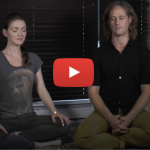
Meditation is the rage. Everyone is talking about it. You hear about it on the 5:00 news, read about it in grocery store magazines…Even your doctor recommends it.
And when people talk about meditating, they all say how good it is for you.
But the unspoken truth is that mediation can be hard—physically hard. Sitting with a neutral spine is demanding. Often, even painful.
Yes, meditation can be painful.
Keeping your back tall is a great way to stay alert and focused, yet relaxed and soft. But if maintaining that neutral spine is painful, all the benefits may disappear.
Meditating with a sore back can make you tense and distracted.
If you have back issues, try these strategies to reduce your pain and make meditation more comfortable.
7 Strategies for Pain Free Meditation
- Meditate in a chair. There’s no rule that meditation has to be done sitting on the floor. Find a firm chair and sit with your feet flat on the ground. You may need to sit away from the back of the chair or find a stool to rest your feet on. Maintain the same soft, tall spine as in sitting meditation.
- Sit on a height. If you really want to sit on the floor, pile up the cushions to help your back relax. Height reduces the pull on the hamstrings and relieves lumbar pain. You can sit tall with less effort.
- Try meditating lying down. Meditation can be done in a variety of positions and it can be helpful to alternate between them. When you lie down, put a pillow under your knees to help release your back. Notice if you feel sleepy or dull, and use that as part of your meditation.
- Try walking meditation. Walking can be a good meditation technique. Some traditions recommend slow, deliberate walking while others use a more normal pace. But at any speed, bring awareness to your body, breath, and surroundings. Moving not only brings relief to your back but also brings new insights to your meditation.
- Warm up your body before sitting. Warm muscles are soft and pliable. Try a gentle Warrior II to open your hips and prepare for sitting. Be gentle with this pose and don’t go too deep. A soft stretch in your hips will help release your back. And as an added bonus, Warrior II gets your blood flowing and helps you be alert.
Another good pose before meditating is Downward Facing Dog. Down Dog stretches your hamstrings, making it easier to stay upright. It opens your chest and shoulders so you can breathe softly.
Plus, it calms your nervous system.
- Do a set of Pilates Knee Folds. A common reason for back pain is that your psoas muscle is tight. Done correctly, Pilates Knee Folds help teach your psoas to work in a relaxed way so you can sit more comfortably.
- Meditate on the pain. Sometimes back pain during meditation is your mind distracting you from meditating. If your body is healthy and your pain isn’t chronic or symptomatic of an injury, try meditating on it. Notice what happens when you bring awareness to it.
When you have back pain in your practice, it’s not uncommon to fight or resist it. The pain is perceived as a barrier to “true” meditation. But the nature of our bodies and our modern lives mean that sitting on a cushion causes many people pain.
Create a practice that works with your body instead of against it. Practice kindness to your back.
In the end, accepting your body will deepen your practice and make you more comfortable.
Julia Rymut is an instructor of contemplative practices in Madison, WI. For more information on finding happiness through embodiment, visit TaraTrue.com.



I have been meditating seated at the beginning. Then, after a surgery of my right knee, being anable to fold my leg, i meditated lie down. At the start, it was great. Now, i fall asleep every time. Do you have a solution ? Thank you !
Hi Catherine,
I have the same issue–I’m much more likely to fall asleep when I’m lying down.
I handle this a few ways:
–Sometimes I change my meditation every few minutes or when I start to feel sleepy. In other words, I may focus on breath, then change to open meditation, then change to body awareness. This keeps me fresh and interested.
–Sometimes I meditate on the sleepy feeling. I notice exactly what it feels like in my body. I try to be aware of every sensation and every change as I go through the sleepiness.
–And sometimes, I go to sleep. As Jessica says (below), I might just need sleep.
I hope these ideas help.
I mostly meditation lying down and give my spine a break. I figure if I fall asleep that is what my body needed, and I find that rarely happens. Thanks for this.
I agree, Jessica. Sometimes I just need sleep. I find that I’m kinder to myself if I just acknowledge it and let myself sleep!